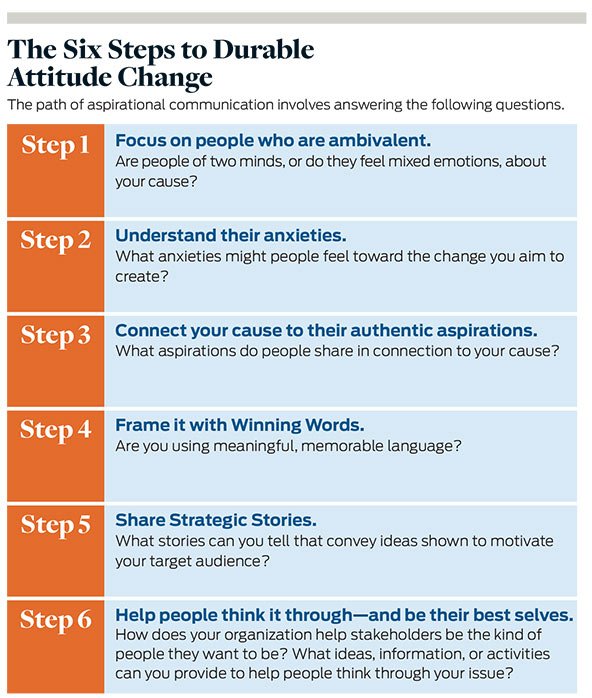Lessons for Social Change Communications Strategy From the US Marriage Equality and Antismoking Campaigns

my notes ( ? )
Organizations must connect their causes to the personal aspirations of their audiences to transform public attitudes... having a majority is not enough... You need a majority that can’t be eroded or peeled away... in 1996... 27 percent of the US public supported legal recognition of same-sex marriages... 60 percent in 2015 ... the new normal... achieved ... “durable attitude change”... beating back a relentless campaign to maintain the status quo by powerful politicians... and deep-pocketed groups...
I assess that extraordinary feat through the lens of Aspirational Communication... suggest a six-step framework ... to drive durable attitude change... demonstrate how the framework also applies to ... youth smoking. ... In 2000, 23 percent of American teenagers reported smoking... 5 percent in 2019... by promoting an “aspirational identity” to at-risk adolescents... our image of the kind of people we truly want to be...
Step 1: Focus on People Who Are Ambivalent... who say they are “of two minds”
Step 2: Understand Their Anxieties... anxiety can disrupt attention, concentration, and memory, prompting people to shut down, rather than open up to new ideas
Step 3: Connect Your Cause to Their Authentic Aspirations... tapping into ideas and emotions that define and motivate them opens an efficient route to addressing their anxieties... aspirations and values that people with different backgrounds and perspectives share can help them “see themselves” in a cause...We recognize our common humanity...
The ideal articulated in ... “for better or for worse,” was shared... we’re most likely to trust people similar to us... Voters who understood that same-sex couples shared their own aspirations for marriage were less likely to feel threatened...
to design a brand focused on adolescent aspirations:... independent from adults, express individuality, more control... narrative focused on “socially irresponsible behavior of the tobacco industry... ability of youth to rebel ... take control of their lives... establishing independence.
Step 4: Frame It With Winning Words ... simple but meaningful words... define the issue in terms that win over the target audience...
people’s shared aspirations for marriage... reframe the cause as honoring “love and commitment.”... Two words helped take the moral high ground ... Who wants to stand in the way of love and commitment?
teen tobacco... campaign’s core narrative: Truth... positions young people as autonomous, independent truth-tellers... “be the generation that ends smoking for good”—speaks to the aspirational identity of today’s young people as changemakers...being an agent of positive change in the world is a powerful aspirational identity ... Millennials in particular
Step 5: Share Strategic Stories...
“love and commitment”... established the foundation for a new storytelling strategy...: Share stories of couples in loving, committed relationships...
challenging, thought-provoking... images of teens in control, rebelling against forces that would prevent them from expressing their independence... gave young people the sense of being part of a social movement...fostered camaraderie... used young people involved in local campaigns to tell its story... strategic and authentic
Step 6: Help People Think It Through—and Be Their Best Selves... help ambivalent voters think through the issue on their own terms—and decide to live up to their own aspirations...
truly changing attitudes about a controversial topic... takes more than pushing emotional buttons... it takes “elaboration”... Elaboration Likelihood Model ... “central route”... Those who take the time to think through... are more likely to change their minds in a meaningful way... the new attitude persists...
Freedom to Marry helped people elaborate through advertisements that modeled the mental “journey”... the idea the Golden Rule expresses—treat others as you’d like to be treated—influenced many people who changed their minds... reminded audience of the kind of people they aspired to be...
Messages using nouns of identity like these are more likely to motivate people to take action... they communicate that a behavior reflects the kind of person one is... Seeing their own identities, aspirations, and values ... motivated many people to... think through the issue...
We transformed the question from ‘How do you feel about gays?’ to ‘What kind of person are you?’
Read the Full Post
The above notes were curated from the full post ssir.org/articles/entry/lessons_for_social_change_communications_strategy_from_the_us_marriage_equality_and_antismoking_campaigns.Related reading
More Stuff I Like
More Stuff tagged messaging , elaboration , narratives , aspire , cognitive , authenticity , politics , social , storytelling , communications
See also: Communication Strategy , Content Strategy , Social Media Strategy , Communications Tactics , Psychology , Politics , Communications Strategy